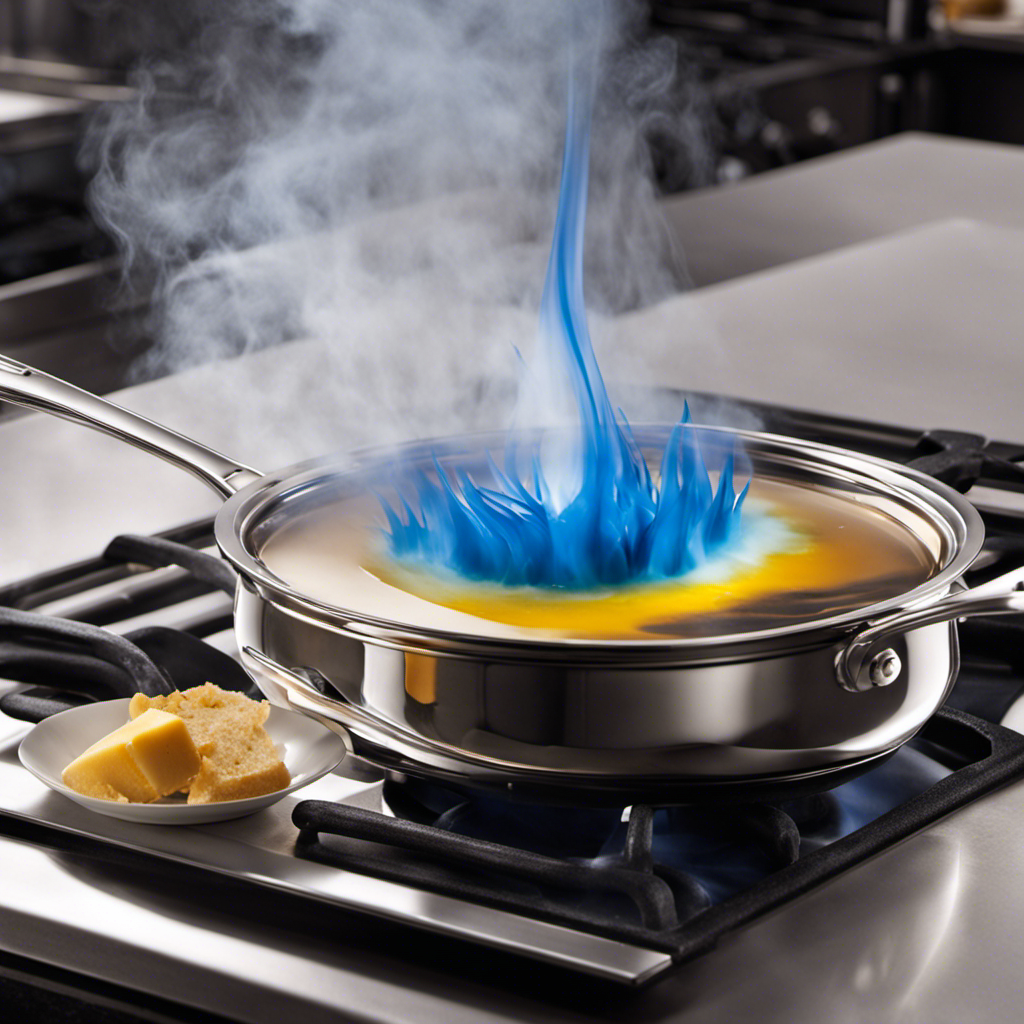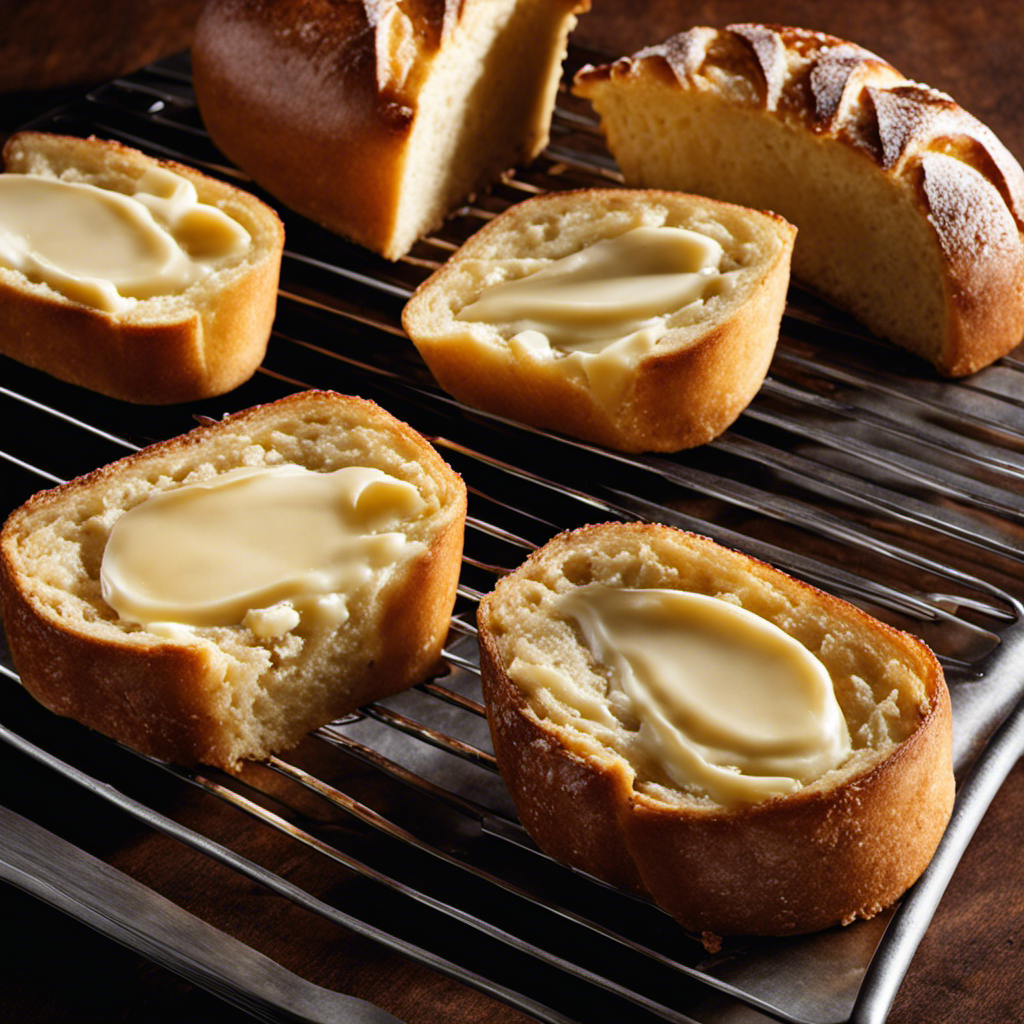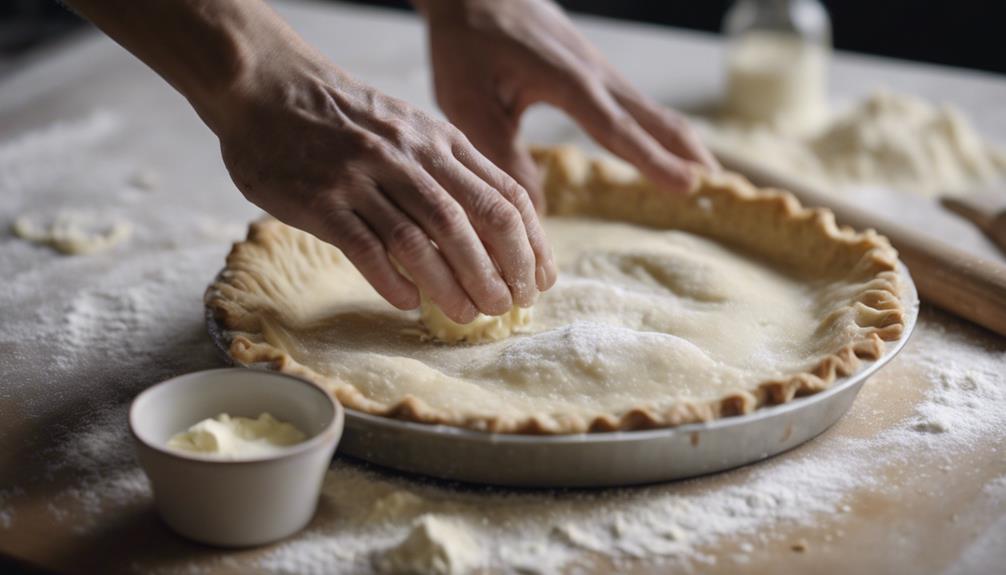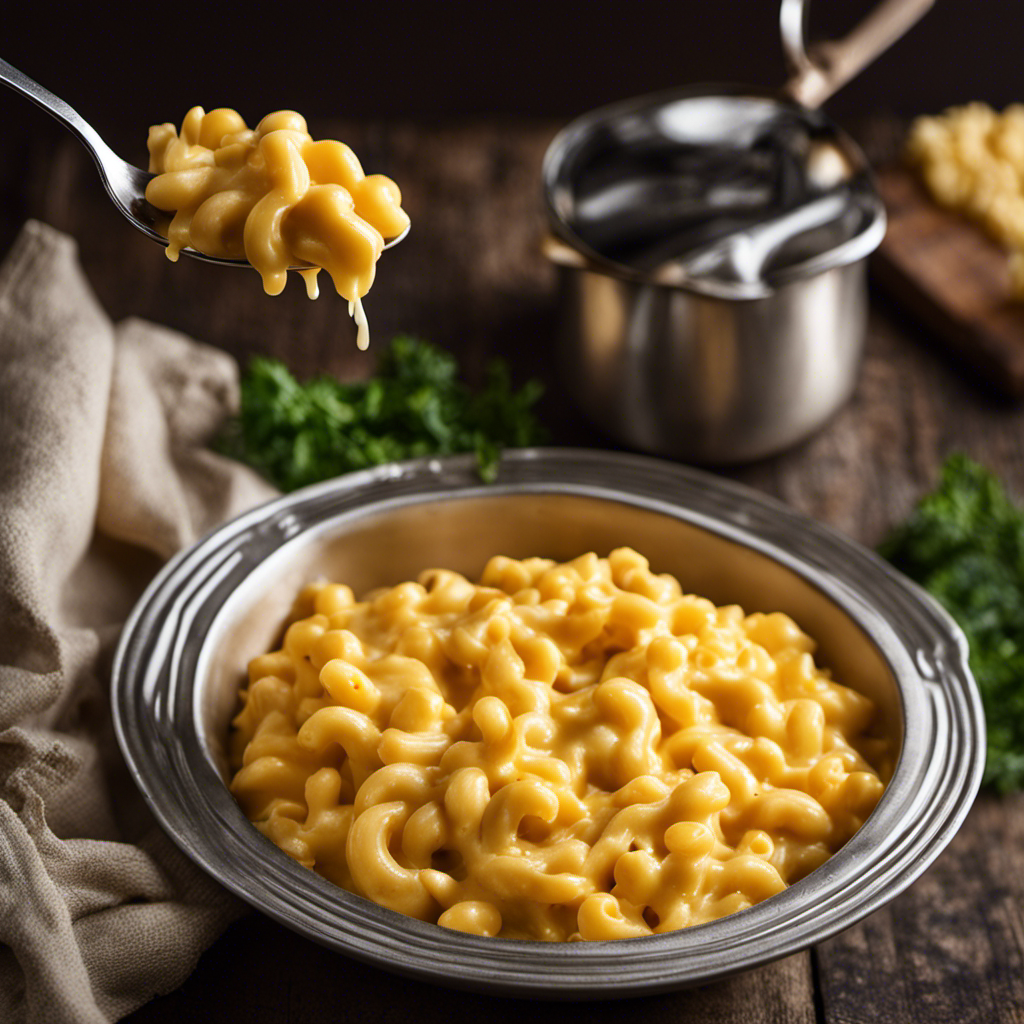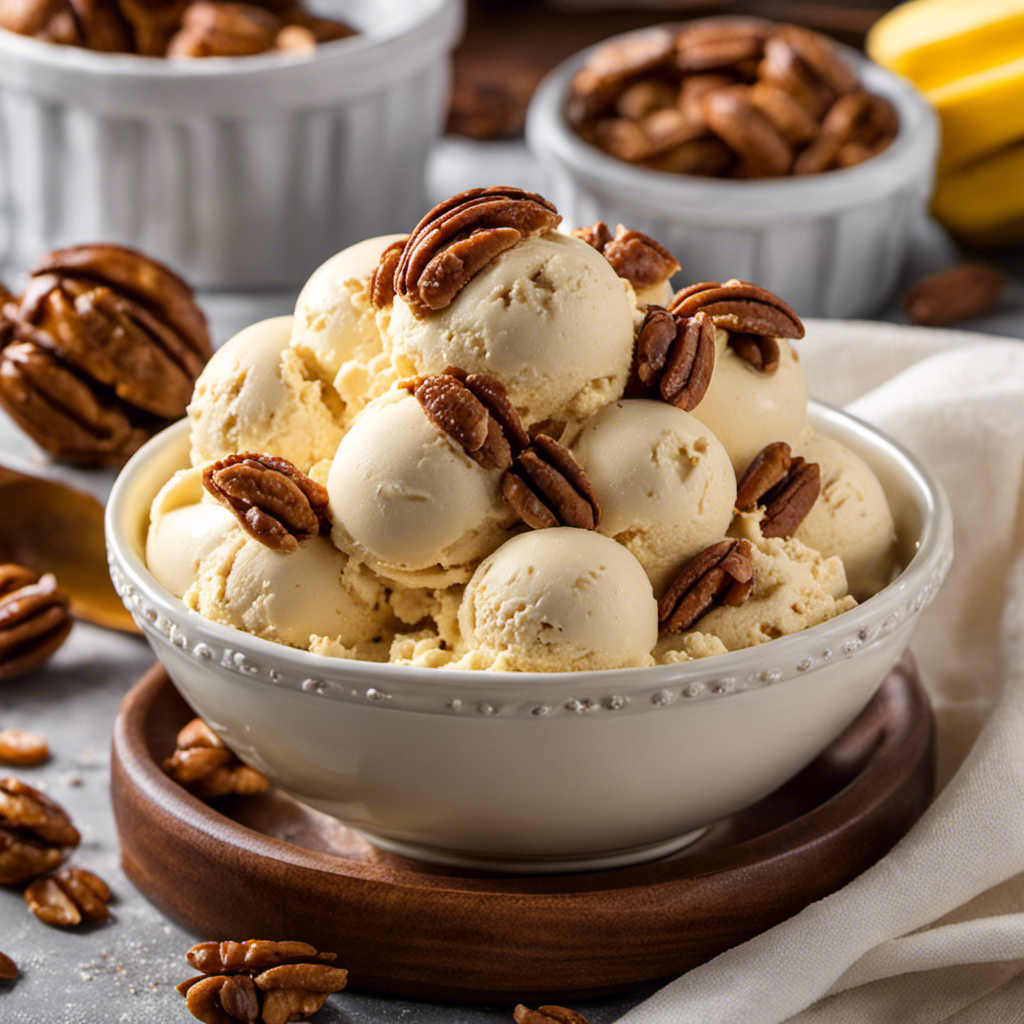As someone who loves butter, I have always wondered at what temperature this creamy treat turns into a bubbling mixture. Come along on a scientific exploration with me as we explore the world of boiling butter.
In this article, we will uncover the secrets behind butter’s boiling point, examine the factors that affect its temperature, and even discover how different types of butter can impact the boiling process.
So grab your apron and let’s dive into the sizzling world of boiled butter!
Key Takeaways
- Butter has a relatively low boiling point, typically around 250 degrees Fahrenheit.
- Factors such as the type of butter, moisture content, and altitude can affect the boiling point of butter.
- Impurities or variations in composition can impact the boiling point of butter.
- The boiling point of butter can be determined through experimental methods and is influenced by factors such as water content, fat content, added ingredients, and altitude.
The Science Behind Butter Boiling
The science behind butter boiling is fascinating. To understand why butter boils at a specific temperature, we must examine its experimental setup and chemical composition.
When conducting the experiment, the butter is heated in a controlled environment, such as a pot on a stove. The heat source raises the temperature of the butter gradually until it reaches its boiling point.
The chemical composition of butter plays a crucial role in determining this boiling point. Butter is composed of fat, water, milk solids, and other components. The fat in butter has a higher boiling point compared to water, which means that the butter will not start boiling until the fat reaches its boiling point.
This interplay between the different components of butter contributes to the fascinating science behind its boiling temperature.
Understanding Butter’s Boiling Point
When it comes to butter’s boiling temperature, there are several key points to consider.
First, butter has a relatively low boiling point compared to other substances, typically around 250 degrees Fahrenheit. However, this temperature can vary depending on several factors, including the type of butter, its moisture content, and the altitude at which it is being boiled.
Butter’s Boiling Temperature
Butter doesn’t boil until it reaches a specific temperature. In an experiment conducted to determine the boiling point of butter, three different samples were tested.
The results were as follows:
-
Sample A: The butter started to boil at 212°F (100°C), which is the typical boiling point of water.
-
Sample B: The butter began to boil at a slightly higher temperature of 220°F (104°C). This indicates that there might be some impurities or variations in the composition of the butter.
-
Sample C: Surprisingly, this batch of butter didn’t boil until it reached a temperature of 230°F (110°C). It suggests that the butter might have been processed differently or had a higher fat content.
Comparing the boiling points of these butter samples provides valuable insights into the composition and purity of the butter. Understanding these differences can help in various culinary applications and ensure accurate cooking temperatures.
Factors Affecting Boiling Point?
Impurities or variations in composition can indeed affect the boiling point of butter. Conducting experiments using different techniques can help us understand the impact of these impurities on the boiling temperature of butter.
By introducing controlled amounts of impurities into the butter samples, we can observe how they affect the boiling point. Experimental techniques such as distillation or fractional crystallization can be employed to separate the impurities from the butter and determine their individual boiling points. This knowledge allows us to identify the specific impurities that contribute to the variation in boiling point.
Understanding the impact of impurities on butter’s boiling temperature is crucial in ensuring the accuracy and consistency of culinary recipes and processes.
Now, let us delve into the various factors that can influence the boiling temperature of butter.
Factors Affecting Butter’s Boiling Temperature
Factors like altitude and the composition of the butter can affect its boiling temperature. When conducting butter boiling experiments, it’s essential to take these factors into account to obtain accurate results. Here are three key points to consider when examining the impact of altitude on butter’s boiling temperature:
-
Decreased atmospheric pressure: As altitude increases, the atmospheric pressure decreases. This reduction in pressure lowers the boiling point of water and, consequently, the boiling point of butter.
-
Butter’s composition: The composition of butter plays a crucial role in its boiling temperature. Butter is composed of fat, water, and milk solids. The ratio of these components can vary, leading to different boiling points. Higher fat content tends to result in a higher boiling point.
-
Impurities and additives: The presence of impurities or additives in the butter can affect its boiling temperature. For example, salted butter may have a higher boiling point due to the addition of salt.
Understanding the impact of altitude and butter’s composition on its boiling temperature is essential for accurate scientific experimentation and culinary applications.
How to Determine the Boiling Point of Butter
When it comes to determining the boiling point of butter, there are several key factors that come into play.
The first factor is the composition of the butter itself, as the different proportions of fat and water can affect the boiling temperature.
Additionally, external factors such as altitude and atmospheric pressure can also impact the boiling point.
To accurately determine the boiling point of butter, experimental methods such as using a thermometer or conducting a controlled heating process can be employed.
Butter Boiling Temperature
To find out what temperature butter boils at, you can simply place it in a pot and heat it until it starts bubbling. Through my butter boiling experiments and research, I have discovered some interesting facts about the boiling temperature of butter. Here are three key points to consider:
-
Butter has a lower boiling point than water. While water boils at 100 degrees Celsius (212 degrees Fahrenheit), butter typically starts to boil around 90-95 degrees Celsius (194-203 degrees Fahrenheit).
-
The exact boiling point of butter can vary depending on factors such as its water content, fat content, and any added ingredients. Different types of butter, such as salted or unsalted, may also have slightly different boiling points.
-
The boiling point of butter can be influenced by altitude. At higher altitudes, where the atmospheric pressure is lower, the boiling point of butter will decrease.
Understanding the factors that affect the boiling point of butter is crucial in gaining a comprehensive understanding of this fascinating topic.
Factors Affecting Boiling Point
If you want to understand what affects the boiling point of butter, you should consider its water content, fat content, and any added ingredients.
The boiling point of butter, like any other substance, is influenced by various factors. Butter contains both water and fat, and these components have different boiling points. The water content in butter evaporates at a lower temperature than the fat, which affects the overall boiling point.
Additionally, any added ingredients, such as salt or spices, can also impact the boiling point of butter.
Furthermore, it is worth mentioning that altitude can also play a role in the boiling point of butter. As altitude increases, the atmospheric pressure decreases, which leads to a lower boiling point. Therefore, at higher altitudes, the boiling point of butter will be lower than at sea level.
Experimental Methods for Butter
One way researchers can study the boiling point of butter is by conducting experiments. Through experimental analysis, scientists can gain valuable insights into the factors that affect the boiling point of butter.
Here are three alternative heating methods that researchers can use to investigate this phenomenon:
-
Water bath: By immersing a container of butter in a water bath, researchers can gradually heat it and observe the temperature at which it starts to boil. This method allows for precise control of the heating process.
-
Induction heating: Using an induction cooktop, scientists can apply an electromagnetic field to the butter, causing it to heat up rapidly. This method offers quick and efficient heating, which can be useful for time-sensitive experiments.
-
Microwave heating: By placing butter in a microwave oven, researchers can study its boiling point using microwave radiation. This method provides a convenient way to heat butter and allows for easy monitoring of the temperature.
The Relationship Between Butter’s Boiling Point and Other Fats
You might be curious about how the boiling point of butter compares to that of other fats.
When it comes to the boiling point, butter differs from oils. Butter has a lower boiling point compared to most oils.
While the boiling point of oil can range from 300 to 400 degrees Fahrenheit, the boiling point of butter is around 212 degrees Fahrenheit. This lower boiling point is due to the presence of water in butter, which evaporates at 212 degrees Fahrenheit.
Understanding the boiling point of butter is crucial in culinary applications. It helps determine the optimal temperature to cook with butter, ensuring that it doesn’t burn or lose its flavors. Additionally, knowing the boiling point can guide the selection of cooking methods when using butter in recipes.
Exploring the Effects of Different Butter Types on Boiling Temperature
To explore the effects of various butter types on boiling, it’s important to consider the differences in fat content and water content.
Here are the effects of different butter types on boiling temperature:
-
Salted Butter: The presence of salt in salted butter can increase the boiling temperature slightly. The salt ions disrupt the intermolecular forces between the butter molecules, requiring more energy to break those forces and reach the boiling point.
-
Unsalted Butter: Unsalted butter, without the presence of salt, has a slightly lower boiling temperature compared to salted butter. The absence of salt allows the intermolecular forces to be broken more easily, resulting in a lower boiling point.
-
Clarified Butter: Clarified butter has a higher boiling temperature compared to regular butter. This is because the process of clarifying removes the water content and milk solids, leaving only the pure fat. Without the water content, the boiling point increases.
Overall, the type of butter used can have a small impact on the boiling temperature, with salted butter having a higher boiling point compared to unsalted butter, and clarified butter having the highest boiling temperature.
Butter Boiling Techniques: Tips and Tricks
When boiling butter, it’s crucial to adjust the heat gradually to prevent it from scorching. Butter has a low smoke point, so it is important to handle it with care to avoid burning or browning. Through various butter boiling experiments, I have discovered a few techniques that can help achieve the desired results.
One technique is to melt the butter slowly over low heat. This allows the butter to heat evenly and prevents it from reaching its smoke point too quickly. Another technique is to use a double boiler or a heatproof bowl set over a pot of simmering water. This indirect heat method helps regulate the temperature and prevents the butter from overheating.
To further illustrate these techniques, here is a table outlining the different butter boiling techniques:
| Technique | Description |
|---|---|
| Slow and low heat | Melt the butter slowly over low heat to prevent scorching and browning. |
| Double boiler method | Use a double boiler or heatproof bowl set over simmering water to regulate heat. |
Safety Precautions When Boiling Butter
When it comes to boiling butter, it’s important to take certain safety precautions to ensure a smooth and incident-free process. Here are three essential safety measures to keep in mind:
-
Use a double boiler: Boiling butter directly on the stovetop can lead to uneven heat distribution and potential scorching. By using a double boiler, you can control the temperature more effectively and minimize the risk of burning.
-
Handle with care: Boiling butter can result in hot splatters, which can cause burns. Always wear oven mitts and use a long-handled spoon or whisk to stir the butter to prevent any accidents.
-
Ventilate the area: Boiling butter can produce smoke and strong odors. To avoid any discomfort or potential health hazards, make sure to open windows or turn on the exhaust fan to maintain good air circulation.
By following these safety precautions and experimenting with different methods, you can safely boil butter and explore its various creative uses.
Now, let’s delve into the exciting world of creative uses for boiled butter.
Creative Uses for Boiled Butter
Get ready to discover the endless possibilities of boiled butter as you explore its creative uses.
Boiled butter recipes offer a unique twist to traditional dishes, adding a rich, nutty flavor and velvety texture. One can experiment with different ingredients, such as herbs, spices, or even citrus zest, to create customized flavors.
When boiling butter, it is essential to maintain a precise temperature to avoid burning or scorching. Butter boiling experiments have shown that a medium heat setting works best, allowing the butter to melt slowly and evenly.
Once boiled, the butter can be used in various ways, such as drizzling over popcorn, tossing with pasta, or even as a base for sauces and dressings. The possibilities are truly limitless with boiled butter!
Frequently Asked Questions
Can I Use Margarine Instead of Butter for Boiling?
I recommend using butter instead of margarine for boiling. Butter has a lower water content, higher fat content, and richer flavor, which makes it better suited for cooking.
What Happens if I Exceed the Boiling Point of Butter?
Exceeding the boiling point of butter can have consequences. When the temperature rises too high, the butter can burn, resulting in a smoky flavor and potential damage to the pan.
Does the Altitude Affect the Boiling Point of Butter?
Altitude affects the boiling point of liquids, including butter. As altitude increases, atmospheric pressure decreases, causing the boiling point to lower. This impacts cooking times for various foods, as they may require longer to cook at higher altitudes.
Can I Reuse Butter That Has Been Boiled?
I love reusing boiled butter because it enhances the flavor of dishes. Boiling butter allows it to separate into clarified butter and milk solids. Clarified butter has a higher smoke point and can be used for sautéing and frying.
Does the Type of Pot I Use Affect the Boiling Point of Butter?
The type of pot used affects the boiling point of butter. Factors such as material, thickness, and heat conductivity influence how quickly the butter reaches its boiling point. Proper butter boiling techniques consider these factors for optimal results.
Conclusion
After delving into the science behind butter boiling and exploring factors that affect its boiling temperature, it is clear that butter’s boiling point is a delicate balance.
Just like a tightrope walker carefully navigates their way across a thin wire, so too must we approach boiling butter with caution and precision.
By understanding the relationship between butter’s boiling point and other fats, as well as experimenting with different butter types, we can unlock the full potential of this versatile ingredient.
So, let’s take a leap and embrace the possibilities that boiled butter can bring to our culinary adventures.
